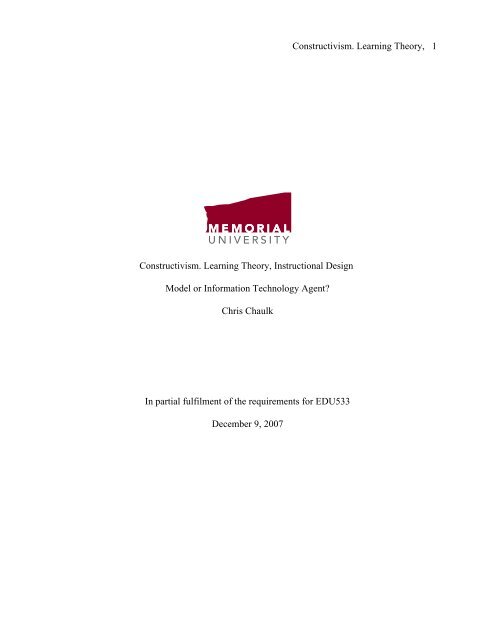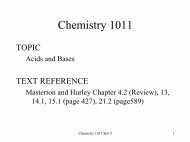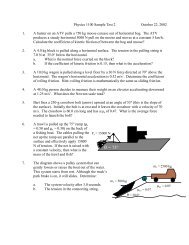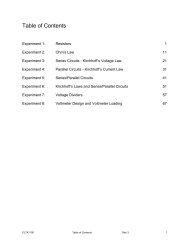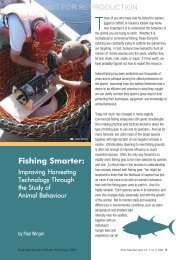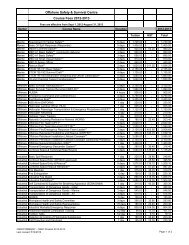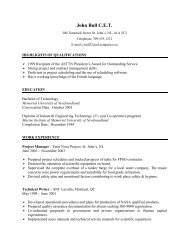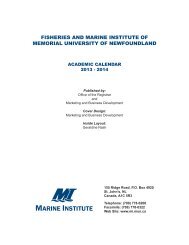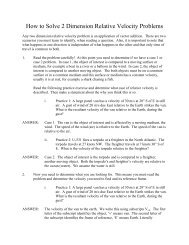Constructivism. Learning Theory, 1 Constructivism. Learning Theory ...
Constructivism. Learning Theory, 1 Constructivism. Learning Theory ...
Constructivism. Learning Theory, 1 Constructivism. Learning Theory ...
- No tags were found...
You also want an ePaper? Increase the reach of your titles
YUMPU automatically turns print PDFs into web optimized ePapers that Google loves.
<strong>Constructivism</strong>. <strong>Learning</strong> <strong>Theory</strong>, 1<strong>Constructivism</strong>. <strong>Learning</strong> <strong>Theory</strong>, Instructional DesignModel or Information Technology Agent?Chris ChaulkIn partial fulfilment of the requirements for EDU533December 9, 2007
<strong>Constructivism</strong>. <strong>Learning</strong> <strong>Theory</strong>, 2IntroductionThe development of an Instructional Design (ID) model, the <strong>Learning</strong> = CM 2 Model(Chaulk & Clement, 2007), based upon constructivism, created confusion about the role and theeffectiveness of constructivism. This paper attempts to clarify whether constructivism is alearning theory, an ID model, or an agent for Information Technology (IT).<strong>Learning</strong> <strong>Theory</strong>Fosnot states “<strong>Constructivism</strong> is not a theory about teaching. It’s a theory aboutknowledge and learning” (Brooks & Brooks, 1993, as cited by Boethel and Dimock 1999).Cognitive constructivism emphasises exploration and discovery by the learner and socialconstructivism emphasises collaborative efforts of groups of learners (Wilhelmsen, Åsmul &Meistad, 1998). Boethel and Dimock (1999) state that constructivist learning theory emphasizes:learning as an adaptive activity; learning as situated in the context where it occurs; knowledge asconstructed by the learner; the role of experience and prior understanding; resistance to change;and the role of social interaction in learning.“From a cognitive perspective, learning is flawed. The message that is received may notbe the one sent. The student thinks they are right until they apply it and it does not work. Eventhen, they are confused. To ensure comprehension, the concept is applied in increasinglycomplex problems to ensure understanding. You make them practise it. Even then, understandingmay not be complete.” (C. Chaulk, personal communication, September 26, 2007). Knowledgecannot be transferred, but must be constructed by each individual learner and it is only byarticulating that knowledge will errors and misconceptions be identified.So constructivism attempts to create a learning environment that allows each learner toconstruct meaning. <strong>Learning</strong> is flawed, so we increase the complexity of the learning
<strong>Constructivism</strong>. <strong>Learning</strong> <strong>Theory</strong>, 3environment. This seems wrong because the increased complexity will confuse learners and theyhave no reference to know when they are right or if they have arrived. It is like learning to telltime on an analog clock without an expert or a digital clock. Even if another learner agrees withyou, the learner is not confident their answer is right without an external reference.A constructivist learning environment uses open-ended questions to promote extensivedialogue among learners (Rovai, 2004). Specifically, learners use cognitive constructivism asthey generate their initial answers and use social constructivism as they discuss answers in anattempt to find consensus. This process should allow all learners to arrive at the sameunderstanding, but this is not always the case, especially if learners just answer the questions anddo not engage in discussion. “<strong>Constructivism</strong> looks at the learning process of how knowledge isconstructed by each learner. So the meaning of knowledge is not absolute, but is relative andconstructed by the each individual learner.... If knowledge is constructed by individuals, errorswill be made in that construction” (C. Chaulk, personal communication, September 24, 2007).To illustrate this, the course question ‘What kinds of learning theories are being used inthis course now? Are you constructing yet?’ generated many different answers. S. Lowes(personal communication, September 24, 2007) and R. Synk (personal communication, October3, 2007) answered correctly; J. Boutilier (personal communication, September 27, 2007) seesconstructivism and cognitive flexibility; M. Landry (personal communication, September 28,2007), T. Grandy (personal communication, September 29, 2007) and D. Graham (personalcommunication, September 29, 2007) see direct instruction and constructivism; R. Gallant(personal communication, October 2, 2007) sees direct instruction, constructivism and cognitiveflexibility; E. Murray (personal communication, September 23, 2007) sees cognitive flexibility;and P. Butler (personal communication, September 26, 2007) and J. Hiebert (personal
<strong>Constructivism</strong>. <strong>Learning</strong> <strong>Theory</strong>, 4communication, October 5, 2007) see direct instruction and cognitivism. This shows thediversity of initial answers to a question where the actual answer was given in the question.Conceptual change occurs when learners are confronted with information that contradictstheir conceptualizations (Jonassen, 2006). Jonassen feels that low domain knowledge learnerswill not notice the contradictions, low interest learners are unlikely to engage in conceptualchange, and experts are unwilling to change because they feel they are correct. It is not knownthe effect social constructivism had on EDU533 learners, but it is difficult to see all learnersanswering the question correctly by the end of the course. This is a very insignificant example,but it illustrates the misconceptions that can sneak into learner’s understanding when usingconstructivism.“But all of us will experience the same activities and be at different realities at the end”(C. Chaulk, personal communication, September 24, 2007). B. Winsor (personal communication,September 29, 2007) feels that “In the end, we will have all become more knowledgeable withregards to Integration of Instructional Design and Information Technology”. This is the trueweakness of the constructivist learning theory. <strong>Learning</strong> is not guaranteed or absolute, but thelearners become ‘more knowledgeable’!Social constructivism (online discussions) is meant to help all learners seek consensusand understanding, but success depends upon the quality of discussions and learner participation.“If a student does not actively participate in the online discussion, he does not exist” (Black,2005). Klemm (2000, as cited in Black, 2005) believes learners may not realize the purpose orimportance of online discussion or what constitutes as good input. Black (2005) feels animportant part of online discussion is a summary or wrap up of the discussion by the instructoror students.
<strong>Constructivism</strong>. <strong>Learning</strong> <strong>Theory</strong>, 5If a student does not exist if they do not participate, does an instructor who just reads thediscussions exist? Heuer and King (2004) feel the roles and responsibilities of the onlineinstructor are: facilitator; model; planner; coach; and communicator. The participation of theinstructor would help to broaden and deepen the quality of the discussions to ensure all learnersare closer to the desired outcomes. Timely input from an expert would enhance socialconstructivism.Although students are anxious for feedback on their work and curious about theinstructor's position on a topic, it is important to let discussion end before the instructorexpresses an opinion (Bonk & Cummings, 1998, as cited by Chaulk & Clement, 2007). The roleof the instructor in discussion is as the “guide on the side” guiding discussions as opposed to the“sage on the stage” teaching (Heuer & King, 2004) .Instructional DesignSavery and Duffy (1996, as cited by Knowles, Holton III, & Swanson, 2005, p193) stateconstructivist instructional principles are:• anchor all learning activities to a larger task or problem.• support the learner in developing ownership for the overall problem ortask.• design an authentic task.• design the task and the learning environment to reflect the complexity ofthe environment in which learners should be able to function at the end oflearning.• give the learner ownership of the process used to develop a situation.• design the learning environment to support and challenge the learner’sthinking.• encourage testing ideas against alternate views and alternative contexts.• provide opportunity for and support reflection on both content learnedand the learning process.Bonk and Cummings (1998, as cited by Chaulk & Clement, 2007) feel that finding abalance between interesting real-world projects and not overwhelming learners is a complex
<strong>Constructivism</strong>. <strong>Learning</strong> <strong>Theory</strong>, 6challenge for instructors. To meet the principles of Savery and Duffy, and find a task that wouldbe interesting and do-able, it may be essential for learners to be involved in task selection.Karagiorgi and Symeou (2005) feel that constructivism is a learning theory and not aninstructional-design theory. For Jonassen (1994, as cited by Karagiorgi & Symeou, 2005),constructivist instruction is an oxymoron. This problem was found when developing the<strong>Learning</strong> = CM 2 Model (Chaulk & Clement, 2007). It is an ID model with no instruction, just aset of tasks for the learner, using the ‘learner as designer’. Ultimately, the model may be flawedbecause the learner has to take on too much responsibility.Kirschner, Sweller, and Clark (2006) state that research shows minimal, constructivistbasedinstruction: is less effective than direct instruction for novice and intermediate learners andonly equally effective for expert learners; and may have negative results as learners make errorsconstructing knowledge. They feel that expert learners do better because they use cognitiveprocesses in their long-term memories for guidance.C. Wheeler (personal communication, October 8, 2007) feels “constructivism is aboutrelating new content to something that students can already relate to”. This explains why expertlearners can use constructivism effectively and novice/intermediate learners struggle.“Working memory is severely limited in capacity when dealing with novel informationsourced from the external environment but largely unlimited when dealing with familiar,organized information sourced from long-term memory” (p116, Kirschner, Sweller & Clark,2007). They feel the search for answers forces novice learners to overload their workingmemory, with little transfer to long-term memory. They feel that weak guidance causes cognitiveoverload for learners as they form weak problem-solving strategies. They suggest that workedexamples and process worksheets are good examples of guided instruction to allow novice
<strong>Constructivism</strong>. <strong>Learning</strong> <strong>Theory</strong>, 7learners to reduce working memory loads and learn the process to solve problems and changelong-term memory.Kirschner et al (2006) feel the two main assumptions of minimal guidance are: learnersconstructing their own solutions to authentic problems; and knowledge is best acquired byexperience. They feel it applies to: discovery learning; problem-based learning; inquiry learning;experiential learning; and constructivist learning. According to Spiro, Feltovich, Jacobson andCoulson (1995), “An instructional approach should be no more complicated than it needs to be.However, instruction must be as complicated as is necessary to achieve the established goals oflearning”. When designing instruction, it is essential to keep in mind learners can be easilydistracted and discouraged. Even if the goal is to teach learners how to solve problems, it may bebest if a number of worked examples are provided so that the learner can step through theprocess. By reducing instruction, to a set of tasks the learner must complete, constructivismincreases the complexity of learning. It may be more meaningful, but the essential learning maybe missed as the learner is distracted by completing other components of the task.Spiro et al (1995) feel that learning can be based on simplification of concepts instructured knowledge domains, but oversimplification of concepts in complex and ill-structureddomains can cause misconceptions for learners. They feel oversimplification occurs fromlooking at knowledge from just one perspective, which causes important aspects of conceptualunderstanding to be missed and they propose a form of constructivism called the cognitiveflexibility theory, which promotes the flexible use of pre-existing knowledge. Learner’sconstruct new meaning from prior knowledge and construct the prior knowledge from differentlong-term memories. For example, to solve an applied math problem, a learner may have tointerpret a word problem, use various math theories (eg. vector addition, trigonometry, etc.), and
<strong>Constructivism</strong>. <strong>Learning</strong> <strong>Theory</strong>, 8sketching.“So how do you teach something that has multiple correct solutions with a flawedlearning system? ... The solution is simple. Look at the task from a number of differentperspectives. As the student experiences each different perspective, it increases theirunderstanding of the task. The process is flawed, so we make it redundant.” (C. Chaulk, personalcommunication, September 26, 2007). “... topics that fall into the ‘ill-structured domains’ mustbe taught and taught again through multiple means. This will help ensure that mastery of thetopic has been achieved. Failure to do so according to Spiro et al (1995), will have studentstackling future problems ill-prepared, since they may carry misconceptions with them fromprevious learning experiences.” (G. Winsor, personal communication, October 9, 2007). Spiro etal (1995) feel:Errors of oversimplification can compound each other, building larger scalenetworks of durable and consequential misconception. The tendency towardsoversimplification applies to all elements of the learning process, includingcognitive strategies of learning and mental representation, and instructionalapproaches.Education and learning are ill-structured and education theories are oversimplifications.<strong>Constructivism</strong> is a learning theory that is being used as an ID model. “A theory explainslearning from the perspective (or constructivist reality) of the theorist. Another theorist canexplain the same learning event from a completely different perspective. Both are right withinthe perspective of each theorist and each theorist tries to explain or carve out as much of thelearning experience as possible. But at some point, all theories break down.” (C. Chaulk,personal communication, October 10, 2007).Cognitive Flexibility (Spiro et al, 1995) differs from constructivism in that the learnermust construct meaning from knowledge that is specified. This may be a way around the
<strong>Constructivism</strong>. <strong>Learning</strong> <strong>Theory</strong>, 9cognitive overload concerns of Kirschner et al about constructivism.Information TechnologyReeves and Jonassen (1996) state that designers of instruction learned the most(designers as learners) because “the process of instructional design forced them to reflect upontheir knowledge in a new and meaningful way”. Glasser (n.d., as cited by Brogan, 1999) statesthat we learn: 10% of what we read; 20% of what we hear; 30% of what we see; 50% of what wesee and hear; 70% of what we discuss with others; 80% of what we experience; and 95% of whatwe teach someone else. So the highest level of learning occurs when teaching other learners.Reeves and Jonassen (1996) feel education benefits when learners use computers ascognitive tools to try to represent what they know (learners as designers). They feel “studentslearn and retain the most from thinking in meaningful (mindful) ways. Some of the best thinkingresults when students try to represent what they know”. They feel learners use cognitive tools ormindtools to organize, restructure, and represent their knowledge. When learners use computers,the workload is divided into areas each partner is good at: computers calculate, store, andretrieve information; and learners recognize and judge patterns of information and organizeinformation (Jonassen, Carr, & Yueh, 1998).Jonassen, Peck and Wilson (1999, as cited by Jonassen, 2000) feel the learning ismeaningful when it is: active; constructive; intentional; authentic; and cooperative. Jonassen(2000) feels learners learn with computers when they support: knowledge construction;explorations; learning by doing; learning by conversing; and learning by reflecting. “Mindtoolsrequire students to draw on a deeper knowledge and pull together different aspects of priorknowledge in the same way as cognitive flexibility” (P. Butler, personal communication,September 26, 2007).
<strong>Constructivism</strong>. <strong>Learning</strong> <strong>Theory</strong>, 10A mindtool is essentially any computer program the learner uses to engage and facilitatecritical thinking and higher order learning (Jonassen, 2000). Jonassen list them as: databases;semantic networks (concept maps); spreadsheets; expert systems; system modelling tools;microworlds; search engines; visualization tools; multimedia publishing tools; live conversationenvironments; and computer conferences. This list can also include the Web 2.0 tools: blogs;wikis; social bookmarking; podcasts; and RSS feeds.Mindtools are a constructivist use of technology (Jonassen, Carr, & Yueh, 1998) thathelps learners construct models of their understanding. By representing learner’s understanding,constructivism functions as an agent for incorporating IT into education. The old adage, a pictureis worth a 1000 words was demonstrated as each group in EDU533, used mindtools to presenttheir ID model. The best usage for constructivism may be to represent the learner’sunderstanding.The additional cognitive load of using mindtools, forces instructors to balance curriculumrequirements vs meaningful learning experiences (Jonassen, 2006). The instructor must “balancedeeper understanding vs. time consumed” (C. Chaulk, personal communication, October 8,2007) when using mindtools.
<strong>Constructivism</strong>. <strong>Learning</strong> <strong>Theory</strong>, 11ConclusionIn many ways this paper feels like a personal reflection paper as the discussion wasmined for appropriate content. EDU533 has been an interesting first course in the M.Ed. ITdegree.Cognitive flexibility theory states that in ill-structured domains such as learning, deeperunderstanding comes from revisiting the information in different ways. This paper examined therole of constructivism, so it’s main benefit is an increased understanding of constructivism.The best use for constructivism is as an agent for the integration of IT into education. Asfor whether constructivism is a learning theory and/or ID model, no real conclusion can bereached, but it is being used as both. <strong>Constructivism</strong> can produce weak learning as a learningtheory, and weak problem-solving skills due to cognitive overload as a ID model.Maybe the best usage of constructivism is as portion of a blended course withobjectivism to expose learners to real-world (authentic) tasks for meaningful learning. This waythe instructor can set up the task so that the workload is manageable for learners.The premise of this paper would require considerable time and research to prove, whichis beyond the expectations and capabilities of this course. But the concerns and argument arelegitimate when based upon a learner’s reality. As C. Chaulk (personal communication,September 16, 2007) says “using the constructivist style, all answers are correct because theycome from your individual reality at the time. A false can become a true as your realitychanges”.
<strong>Constructivism</strong>. <strong>Learning</strong> <strong>Theory</strong>, 12ReferencesBlack, A. (2005). The use of asynchronous discussion: Creating a text of talk. Contemporaryissues in technology and teacher education, 5 (1). Retrieved November 15, 2007 from:http://www.citejournal.org/vol5/iss1/languagearts/article1.cfmBoethel, M., & Dimock, K.V. (1999). Constructing knowledge with technology: A review of theliterature. Austin, Texas: Southwest Educational Development Laboratory. RetrievedDecember 2, 2007 from:http://elearning.cbu.ca:8900/EDUC533_91_2007FW/constructing.pdfBrogan, P. (1999). Using the web for interactive teaching and learning. White paper.Macromedia Press. Retrieved December 2, 2007 from:http://www.ced.ntu.edu.sg/acedemia/vol_1/06/whitepaper_interactive.pdfChaulk, C. & Clement, A. (2007). The learning = CM 2 model.Heuer, B., & King, K. (2004). Leading the band: The role of the instructor in online learning foreducators. Journal of Interactive Online <strong>Learning</strong>, 3:1, 1-11, Retrieved December 8, 2007from: http://www.ncolr.org/jiol/issues/PDF/3.1.5.pdfJonassen, D.H. (2000). Computers as mindtools for schools: Engaging critical thinking, (2nded.). Upper Saddle River: Merrill.Jonassen, D. H. (2006). Modeling with technology: Mindtools for conceptual change (3rd rev.ed.). Columbus, OH: Pearson/Prentice Hall.Jonassen, D.H., Carr, C., & Yueh, H.-P. (1998). Computers as mindtools for engaging learners incritical thinking, Techtrends, 43 (2), 24-32. Retrieved November 15, 2007 from:http://software.fisica.uson.mx/MindTools/Mindtools.pdfKaragiorgi, Y. & Symeou, L. (2005). Translating constructivism into instructional design:Potential and limitations. Educational Technology & Society, 8 (1), 17-27. RetrievedNovember 30, 2007 from: http://www.ifets.info/journals/8_1/5.pdfKirschner, P. A., Sweller, J., & Clark, R. E. (2006). Why minimal guidance during instructiondoes not work: An analysis of the failure of constructivist, discovery, problem-based,experiential, and inquiry-based teaching. Educational Psychologist, 41: 2, 75-86. RetrievedDecember 2, 2007 from: http://www.leaonline.com/doi/pdf/10.1207/s15326985ep4102_1Kirschner, P. A., Sweller, J., & Clark, R. E. (2007). Why minimally guided teaching techniquesdo not work: A reply to commentaries. Educational Psychologist, 42:2, 115-121. RetrievedDecember 2, 2007 from:http://www.leaonline.com/doi/pdfplus/10.1080/00461520701263426
<strong>Constructivism</strong>. <strong>Learning</strong> <strong>Theory</strong>, 13Knowles, M. S., Holton III, E. F., & Swanson, R. A. (2005). The adult learner: The definitiveclassic in adult education and human resource development (6th ed.). Burlington, MA:Elsevier.Reeves, T. C., & Jonassen, D. H. (1996). <strong>Learning</strong> with technology: Using computers ascognitive tools. Jonassen, D. H. (Ed.), Handbook of research for educationalcommunications and technology, 693-719. New York, NY: Simon & Schuster Macmillan.Retrieved November 18, 2007 from:http://elearning.cbu.ca:8900/EDUC533_91_2007FW/cogtools.pdfRovai, A.P. (2004). A constructivist approach to online college learning. The Internet andHigher Education, 7:2, 79-93. Retrieved December 8, 2007 from:http://dx.doi.org/10.1016/j.iheduc.2003.10.002Spiro, R.J., Feltovich, P.J., Jacobson, M.J., & Coulson, R.L. (1995). Cognitive flexibility,constructivism, and hypertext: Random access instruction for advanced knowledgeacquisition in ill-structured domains. Institute for <strong>Learning</strong> Technologies. RetrievedNovember 16, 2007 from: http://phoenix.sce.fct.unl.pt/simposio/Rand_Spiro.htmWilhelmsen, S., Åsmul, S.I., & Meistad, Ø. (1998). Psychological theories; A brief survey of thechanging views of learning. Retrieved December 2, 2007 from:http://www.uib.no/People/sinia/CSCL/web_struktur-4.htm


